UNIT – 4
General System of Forces
Question1) Determine the resultant of the system of forces acting on a beam as shown in figure.
Above Force system is Non concurrent force system.
Resolving the forces horizontally,
∑ Fx = - 20 Cos 60 = - 10 KN = 10 KN (towardleft)
Resolving forces vertically,
∑Fy = - 20 – 30 – 20 Sin 60
= - 67.32 KN
∑Fy = 67.32 KN (downwards)
Resultant, R = √ (∑ Fx) 2 + (∑Fy) 2 = √10 2 + 67.322
R = 68.06 KN
Direction of Resultant,
 tanα = ∑Fy / ∑ Fx = 67.32 / 10.00
tanα = ∑Fy / ∑ Fx = 67.32 / 10.00
α = 81.550
Now taking moment about point A & using Varignon’s theorem.
∑MA = Moment of resultant A
(20 x 1.5) + (30 x 3) + (20 Sin 60 x 6) = (∑ Fx x 0 ) + (∑Fyx X)
223.92 = 67.32 x X
X = 223.92 / 67.32 = 3.326 m from point A

Ans
Question 2) For a given force system, find the resultant in magnitude & direction. Also find the location of Resultant.
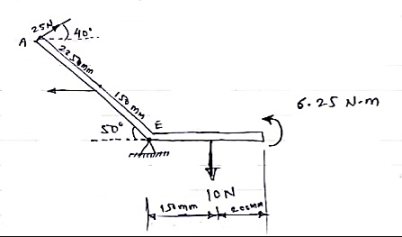
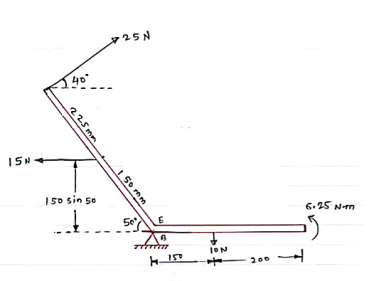
Answer)
Resolving forces horizontally,
∑ Fx = - 15 + 25 Cos 40 = 4.15 N (toward right)
Resolving forces vertically,
∑Fy = 25 Sin 40 – 10
= 6.07 n (upward)
R = √(∑ Fx) 2 + (∑Fy)2
 = √4.152 + 6.072
= √4.152 + 6.072
R = 7.35 N
 tanα = ∑Fy / ∑ Fx = 6.07 / 4.15
tanα = ∑Fy / ∑ Fx = 6.07 / 4.15
α= 55.640 - - - Angle made by resultant
Question 3) To find exact position of R, let x is the perpendicular distance betn R & point B.
Answer 3) Using Varignon’s theorem at point B.
R x X = ∑MB
= (10 x 150) – (15 x 150 Sin 50) + ( 25 x 375 ) – ( 6.25 x 1000 )
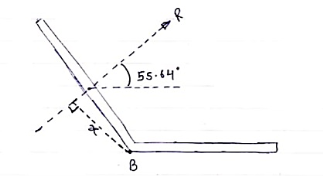 = 1500 – 1723.6 + 9375 – 6250
= 1500 – 1723.6 + 9375 – 6250
= 2901.4 N.mm (clockwise)
x = 2901.4 / R
 = 2901.4 / 7.35
= 2901.4 / 7.35
x = 394.75 mm from point B.
Question 3) Find resultant moment of two couples for the loading as shown in Fig

Answer 3) Moment of 50 N couple is clockwise,
= 50 x 1
= 50 N.m
Moment of 100 N couple is also clockwise
= 100 x 0.8 = 80 N.m.
Resultant Moment = 50 + 80 = 130 N.m
Question 4) Find the resultant and its point of application on y – axis for the force system acting on Triangular plate as shown in fig.
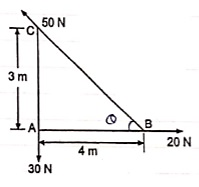
Answer 4)
θ = tan-1 (3/4)
= 36.860 with Horizontal
Resolving forces in x & y dirn
∑ Fx = 20 – 50 Cosθ
= 20 – 50 Cos 36.86
= - 20 N
= 20 N
∑Fy = - 30 + 50 Sin 36.86
= 0.00007
≈ 0
R = √(∑ Fx) 2 + (∑Fy)2
= 20 N toward left (as ∑ Fy = 0 )
Let us apply Varignon theorem at point B
∑MB = R.x
( 30 x 4 ) = Rx
Rx = -120 N.m = 120 N.m
As moment of Resultant is negative i.e. it is anticlockwise
-Rx = -120
X = -120 / -20 = 6 m
X = 6 m from point B and it will be above point. B to create anticlockwise moment.
Question 5) If the resultant moment about point A is 4800 Nm clockwise, determine the magnitude of F3 if F1 = 300 N and F2 = 400 N.
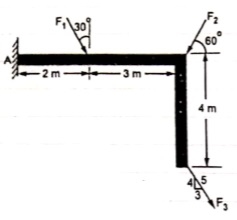
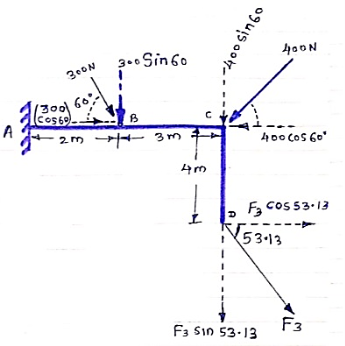 Answer 5): Resultant Moment = 4800 N.m
Answer 5): Resultant Moment = 4800 N.m
Let us apply Varignon’s theorem at point A,
∑MB = (R.x )
[(300 60) x 2] + [(400 Sin 60) x 5] + [(F3 Sin 53.13 x 5)] – [(F3 Cos 53.13) x 4] = 4800
519.62 + 1732.05 + 3.99 F3 – 2.4 F3 = 4800
2251.67 + 1.59F3 = 4800
1.59 F3 = 2548.33
F3 = 2548.33 / 1.59 F3 = 2548.33 / 1.6

 OR
OR
F3 = 1602.72 NF3 = 1592.7 N
Question 6) The three forces shown in Fig. Create a vertical resultant acting through point B. If P = 361 N, compare the values of T and F.

Answer 6) From given figure,
1>. Angle made by Force P is, = tan-1 (3/3) = 450 with Horizontal
2>. Angle made by Force F is, = tan-1 (1/3) = 18.430 with Horizontal
3>. Angle made by Force T is, = tan-1 (3/1) = 71.560 with Horizontal
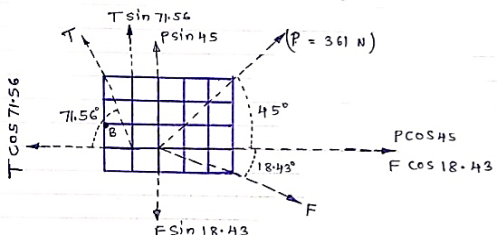
Resolving forces along x & y dirn,
As Resultant is vertical, let it is upward, then
∑ Fx = 0& ∑Fy = R
∑ Fx = P Cos 45 + F Cos 18.43 – T Cos 71.56
0 = 361 Cos 45 + F Cos 18.43 – T Cos 71.56
0 = 255.26 + 0.95 F – 0.32 T
0.95 F – 0.32 T = - 255.26 . . . . (1)
∑Fy = P Sin 45 – F Sin 18.43 + T Sin 71.56
R = 361 Sin 45 – F Sin 18.43 + T Sin 71.56
R = 255.26 – 0.32 F + 0.95 T …… (2)
Now as it is given that Resultant acts at point B, let us apply Varignon’s theorem at point B.
∑MB = R.x
But as R is acting at B point, its perpendicular distance from point B itself will be zero.
∑MB = R.x
(P Cos 45 x 1) – (P Sin 45 x 2) + (T Cos 71.56 x 1) – (T Sin 71.56 x 1) – (F Cos 18.43 x 1) + (F Sin 18.43 x 2) = R x 0
As P = 361 N
-255.26 – (255.26 x 2) + 0.32 T – 0.95 T – 0.95 F + (0.32 F x 2) = 0
-765.78 + 0.32 T – 0.95 T – 0.95 F + 0.64 F = 0
-765.78 – 0.63 T – 0.31 F = 0
– 0.31 F – 0.63 T = 765.78 . . . . (3)
Solving eqn (1) and (3) simultaneously

 0.95 F – 0.32 T = - 255.26
0.95 F – 0.32 T = - 255.26
-0.31 F – 0.63 T = 765.78

F = -581.716 N &

T = -929.282 N
Question 7) Determine the resultant of four forces tangent to the circle of radius 1.5 m as shown. Determine its location w.r.t. ‘O’.
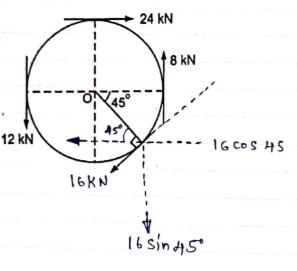
Answer 7) Resolving forces in X and Y direction,
∑ Fx = 24 - 16 Cos 45
= 12.69 KN ( )
∑Fy = -12 + 8 – 16 Sin 45
= -15.31 kN
= 15.31 kN ( )
Resultant R = √(∑ Fx) 2 + (∑Fy)2
 = √ 12.69 2 + (-15.31)2
= √ 12.69 2 + (-15.31)2
R = 19.88 kN
Direction of Resultant,
α = tan-1(∑Fy / ∑ Fx)
 α = tan-1(15.31 / 12.69)
α = tan-1(15.31 / 12.69)
α = 50.350in 4th quadrant
To know exact location of Resultant, let us apply Varignon’s theorem at point O.
∑MO = R.x
-(12 x 1.5) + (24 x 1.5) – (8 x 1.5) + (16 x 1.5) = (19.88 x X)
30 = R.x
As product of R.x is positive it means moment of Resultant is positive. To create positive clockwise moment of Resultant it must be acting on Right side of O (in 4th quadrant).
30 = 19.88 x X
 X = 1.51 m from O on the right hand side.
X = 1.51 m from O on the right hand side.
Question 8) Find the axial force in the bar AB & AC as shown in figure.

 Consider the free body diagram of all forces at B.
Consider the free body diagram of all forces at B.
Answer 8)
Q1 = tan -1  = 51.34º
= 51.34º
Q2 = tan-1  = 45º
= 45º
Let the forces developed in the member AB & AC are FAB &FBCrespectively. The force diagram will be as follows at B.
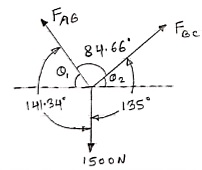 Applying Lami’s Theorem:
Applying Lami’s Theorem:


 FAB = 1067.19 N
FAB = 1067.19 N

FBC = 942.81 N
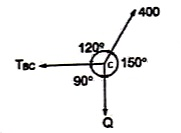 Question 9) Find the tensions in the string AB, BC, CD, DE of the given system as shown in figure. String BC is horizontal & pulley D is frictionless.
Question 9) Find the tensions in the string AB, BC, CD, DE of the given system as shown in figure. String BC is horizontal & pulley D is frictionless.
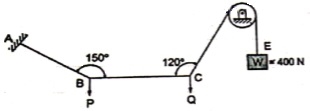
Answer 9)
 The string passes over the pulley & is attached to weight w = 400 N.
The string passes over the pulley & is attached to weight w = 400 N.
Thus TCD = TDE = 400 N
Consider joint C & apply Lami’s theorem



Now consider FBD at joint B
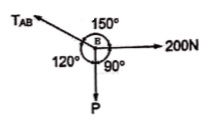
By using Lami’s theorem


TAB = 230.94 N

Question 10) Two identical spheres having weight 1000 N are kept in a container as shown in figure. Find the reaction at all contact surfaces.
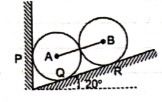
Answer 10)
 Consider the free body diagram of sphere B as shown below:
Consider the free body diagram of sphere B as shown below:
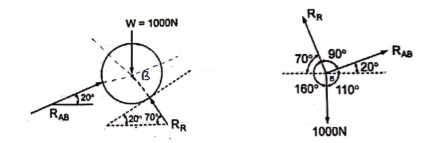
By lami’s theorem


 RRR = 939.69 N
RRR = 939.69 N

 = RAB
= RAB
Now consider FBD of sphere A
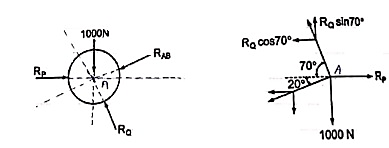
∑Fx = 0
-RB cos 20 – RQ cos 70 + Rp = 0
-342.02 cos 20 – RQ sin 70 + Rp = 0
 Rp = 321.39 + 0.34 RQ ------------------(1)
Rp = 321.39 + 0.34 RQ ------------------(1)
∑ fy = 0
RQ sin 70 – 342.02 sin 20 – 1000 = 0
 RQ = 1188.66 N - put in equation (1)
RQ = 1188.66 N - put in equation (1)
 Rp = 725.5 N
Rp = 725.5 N
Question 11) Two members AB & BC are supporting a load of 200 kN as shown in figure. Find the forces developed in the members AB & BC
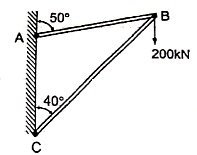
 Answer 11)
Answer 11)
 Consider the free body diagram of joint B as shown in figure
Consider the free body diagram of joint B as shown in figure
Assume that member BC is in compression & AB is in tension. By using Lami’s theorem at B,



 FAB = -740.33 kN
FAB = -740.33 kN
-ve sign indicates that member AB is not in Tension but is in compression.
Now,


-ve sign indicates that member BC is not in compression but in tension.